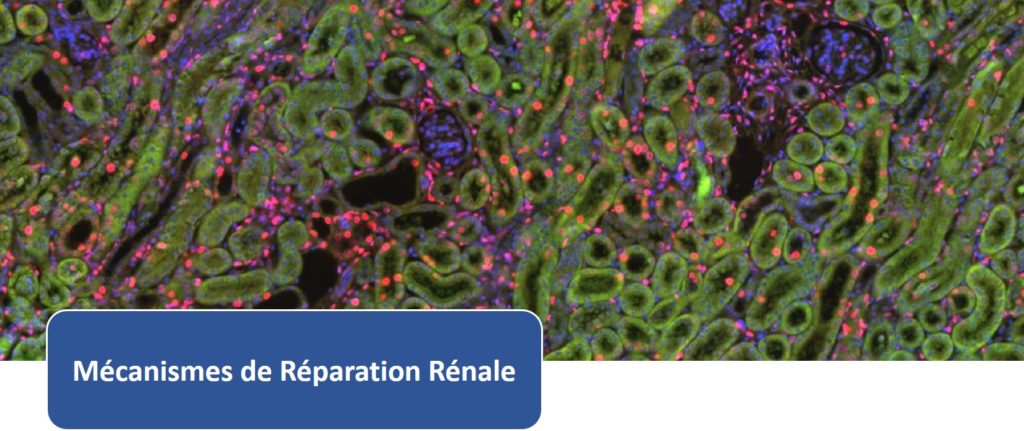
Projects
The kidneys repair after injury through the proliferation of tubular epithelial cells. This proliferative repair is physiologically self-constrained, and early expression of cell cycle inhibitors p53 and p21 reduces initial injury, suggesting that transient cell-cycle arrest might be beneficial in acute kidney injury. These observations prompted the development of a project with multiple axes, aimed at (1) understanding the relationship between cell proliferation and energy production/expenditure, (2) characterising this relationship and its consequences in the early and late stages following an AKI, and (3) evaluating how cell proliferation could be modulated in order to favour renal repair and prevent the transition from AKI to CKD.
We have previously identified Nupr1 (Nulcear Protein 1) as an early stress-response gene conveying epithelial protection in an acute model of renal toxicity. NUPR1 exerts its renoprotective effect during the early phase of AKI by preventing excessive cell proliferation and energy expenditure in the injured tubular epithelium.
Using a combination of state-of-the art in vivo and in vitro techniques on human and animals models, we are currently pursuing the following projects :
- Is Nupr1 administration beneficial during AKI?
- Testing the proliferation hypothesis in the deleterious effect of an early procurement on kidney graft function.
- Real-time assessment of the kidney's metabolic state by non-invasive biomarkers


Publications
- Cell stress response impairs de novo NAD+ biosynthesis in the kidney. Bignon Y, Rinaldi A, Nadour Z, Poindessous V, Nemazanyy I, Lenoir O, Fohlen B, Weill-Raynal P, Hertig A, Karras A, Galichon P, Naesens M, Anglicheau D, Cippà PE, Pallet N. JCI Insight. 2021 Nov 18:e153019. doi: 10.1172/jci.insight.153019.
- Anaesthesia-Induced Transcriptomic Changes in the Context of Renal Ischemia Uncovered by the Use of a Novel Clamping Device. Verney C, Legouis D, Placier S, Migeon T, Bonnin P, Buob D, Hadchouel J, Galichon P. Int J Mol Sci. 2021 Sep 11;22(18):9840. doi: 10.3390/ijms22189840
- Altered proximal tubular cell glucose metabolism during acute kidney injury is associated with mortality. Legouis D, Ricksten SE, Faivre A, Verissimo T, Gariani K, Verney C, Galichon P, Berchtold L, Feraille E, Fernandez M, Placier S, Koppitch K, Hertig A, Martin PY, Naesens M, Pugin J, McMahon AP, Cippà PE, de Seigneux S. Nat Metab. 2020 Aug;2(8):732-743. doi: 10.1038/s42255-020-0238-1.
- Increased Fatty Acid Oxidation in Differentiated Proximal Tubular Cells Surviving a Reversible Episode of Acute Kidney Injury. Bataille A, Galichon P, Chelghoum N, Oumoussa BM, Ziliotis MJ, Sadia I, Vandermeersch S, Simon-Tillaux N, Legouis D, Cohen R, Xu-Dubois YC, Commereuc M, Rondeau E, Le Crom S, Hertig A. Cell Physiol Biochem. 2018;47(4):1338-1351. doi: 10.1159/000490819.
- Rapid Occurrence of Chronic Kidney Disease in Patients Experiencing Reversible Acute Kidney Injury after Cardiac Surgery. Legouis D, Galichon P, Bataille A, Chevret S, Provenchère S, Boutten A, Buklas D, Fellahi JL, Hanouz JL, Hertig A. Anesthesiology. 2017 Jan;126(1):39-46. doi: 10.1097/ALN.0000000000001400.
- Stress Response Gene Nupr1 Alleviates Cyclosporin A Nephrotoxicity In Vivo. Galichon P, Bataille A, Vandermeersch S, Wetzstein M, Xu-Dubois YC, Legouis D, Hertig A, Buob D, Placier S, Bigé N, Lefevre G, Jouanneau C, Martin C, Iovanna JL, Rondeau E. J Am Soc Nephrol. 2017 Feb;28(2):545-556. doi: 10.1681/ASN.2015080936.
